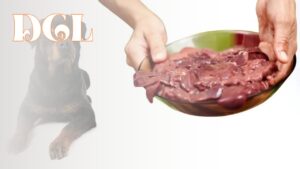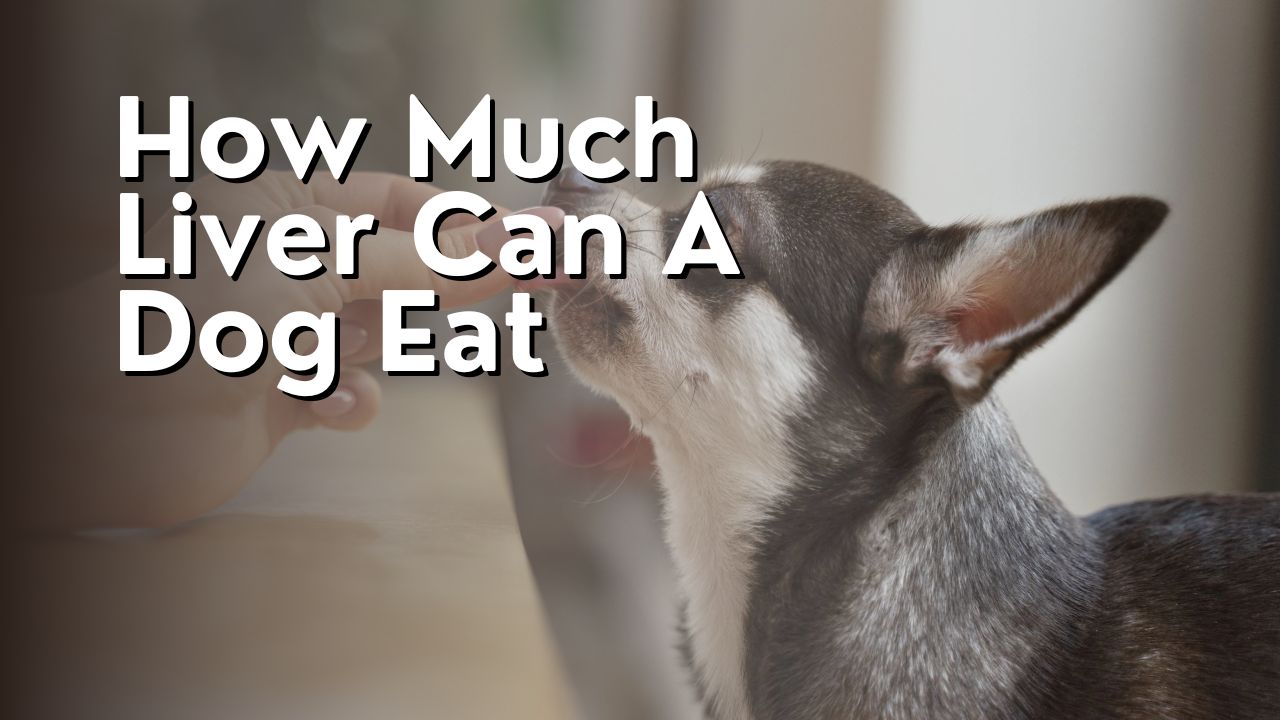Hey there, fellow dog lovers! Have you ever wondered how much liver is safe for your furry friend to consume? Well, you’ve come to the right place.
In this article, I’ll be diving into the topic of how much liver a dog can eat and the nutritional benefits it provides. As a dog owner myself, I understand the importance of maintaining a balanced diet for our canine companions.
The liver is often touted as a superfood for dogs, packed with essential vitamins and minerals. However, it’s crucial to be aware of the potential risks and considerations associated with feeding liver to our four-legged pals.
I’ll also be sharing recommended amounts and frequency of liver in a dog’s diet, as well as tips on preparing and serving it safely.
So, let’s fetch some knowledge and ensure our pups are getting the right amount of liver in their bowls!
The Nutritional Benefits of Liver for Dogs
You’ll be amazed at how beneficial the liver can be for your dog’s nutrition!
The liver is packed with essential nutrients that can greatly enhance your furry friend’s overall health. It is an excellent source of protein, which is necessary for building and repairing tissues, as well as supporting a strong immune system.
The liver is also rich in vitamins A, B, and K, which are crucial for maintaining healthy vision, promoting proper brain function, and aiding in blood clotting.
One of the key benefits of feeding liver to your dog is its high content of iron. Iron is essential for the production of red blood cells, which carry oxygen throughout the body. By incorporating liver into your dog’s diet, you can help prevent anemia and ensure that their organs receive the oxygen they need to function optimally.
The liver is also a natural source of important minerals like zinc and copper, which are necessary for a strong immune system and healthy skin and coat. These minerals play a vital role in maintaining your dog’s overall well-being and can help prevent skin allergies and other common health issues.
In addition to its nutritional value, the liver is also highly palatable for dogs, making it a great choice for picky eaters. Whether you choose to feed fresh liver or incorporate it into homemade dog treats, your furry friend is sure to enjoy the taste while reaping the many benefits.
Overall, the liver is a nutrient-dense food that can greatly contribute to your dog’s overall health and well-being. Adding liver to their diet can provide them with essential nutrients, support their immune system, and promote overall vitality. So why not give your pup a taste of liver and watch them thrive?

Risks and Considerations of Feeding Liver to Dogs
Feeding liver to dogs can have its risks and considerations. While the liver is highly nutritious and beneficial for dogs, it should be given in moderation. Here are a few things to keep in mind:
- Vitamin A overdose: The liver is rich in vitamin A, and excessive consumption can lead to vitamin A toxicity. This can cause symptoms like bone abnormalities, joint pain, and even death in severe cases. It’s crucial to provide the liver in appropriate portions to prevent vitamin A overdose.
- High in cholesterol: The liver is also high in cholesterol, so it should be given sparingly, especially to dogs with existing heart conditions or high cholesterol levels. Moderation is key to maintaining a healthy balance.
- Source and quality: Ensure that the liver you feed your dog is sourced from a reputable supplier and is of high quality. Avoid liver from unknown sources or those that may contain harmful substances.
By keeping these considerations in mind and feeding the liver in moderation, you can safely incorporate this nutritious organ into your dog’s diet.
Recommended Amounts and Frequency of Liver in a Dog’s Diet
Including the liver in your furry companion’s diet on a regular basis can provide a wealth of health benefits. When it comes to determining the recommended amounts and frequency of liver in a dog’s diet, it is important to consider their size, age, and overall health.
As a responsible dog owner, I have done extensive research and consulted with my veterinarian to ensure that I am meeting my dog’s nutritional needs.
Typically, it is recommended to feed liver to dogs in moderation. For small to medium-sized dogs, such as mine, a general guideline is to feed them no more than one ounce of liver per day. Larger dogs may be able to handle slightly larger portions, but it is still important to avoid overfeeding. Additionally, it is crucial to rotate different types of organ meats, including liver, to ensure a balanced diet.
In terms of frequency, I have found that feeding liver to my dog once or twice a week works well. This allows him to enjoy the nutritional benefits without overwhelming his system. However, it is always best to consult with a veterinarian to determine the specific needs of your individual dog.
Overall, including liver in my dog’s diet has been a positive experience. Not only does it provide him with essential nutrients such as vitamins A and B, iron, and zinc, but it also adds variety to his meals. Just remember to feed your liver in moderation and consult with your veterinarian to ensure the best diet for your furry friend.
Preparing and Serving Liver for Dogs
To make the liver a delightful addition to your furry companion’s meals, try incorporating it into homemade dog treats or mixing it with other ingredients for a tasty and nutritious meal. The liver is not only a great source of protein, but it is also packed with essential vitamins and minerals that can benefit your dog’s overall health. Here are some ideas on how to prepare and serve liver for your dog:
- Cooked Liver: Start by washing the liver thoroughly and removing any excess fat. Then, you can either boil or bake it until it is fully cooked. Once cooked, chop it into small, bite-sized pieces that are easy for your dog to eat.
- Liver Treats: You can make liver treats by combining cooked liver with other dog-friendly ingredients such as oats, sweet potatoes, or carrots. Simply blend the ingredients together, shape them into small treats, and bake them in the oven until they are crispy.
- Liver Pate: Blend cooked liver with a bit of water or low-sodium broth to create a liver pate. This can be spread on your dog’s regular food or used as a tasty filling for interactive toys.
- Dehydrated Liver: Slice the liver into thin strips and place them in a food dehydrator or bake them in a low-temperature oven until they are dry and crispy. The dehydrated liver makes a great, crunchy snack for your dog.
By adding liver to your dog’s diet in these different forms, you can provide them with a variety of flavors and textures while ensuring they receive the nutritional benefits of this organ meat.

Monitoring Your Dog’s Health and Adjusting Liver Intake
Now that you’ve added liver to your pup’s diet, it’s important to keep a close eye on their health and make adjustments as needed. While the liver can be a nutritious addition to their meals, it’s crucial to monitor their overall well-being to ensure they are benefiting from it.
One important aspect to watch for is any signs of digestive upset. Some dogs may have sensitive stomachs and may not tolerate a large amount of liver in their diet. If you notice any diarrhea, vomiting, or constipation, it may be a sign that you need to reduce the amount of liver you are feeding them.
Additionally, it’s essential to monitor their weight. The liver is a rich source of nutrients and can be high in calories. If your dog starts to gain weight, you may need to adjust its liver intake to prevent obesity. On the other hand, if your dog is losing weight or appears to be lacking energy, it could be a sign that they need more liver or other sources of nutrients in their diet.
Regular veterinary check-ups are also essential to ensure your dog’s overall health. Your vet can help you determine the right amount of liver to feed your pup based on their specific needs and any underlying health conditions they may have.
In conclusion, monitoring your dog’s health and adjusting its liver intake as needed is crucial for its overall well-being. By paying attention to any digestive issues, and weight changes, and regularly consulting with your vet, you can ensure that your pup is getting the most out of their liver-rich diet.
Frequently Asked Questions
Can all dogs safely eat liver, or are there certain breeds that should avoid it?
All dogs can safely eat liver, regardless of their breed. It is a nutritious and beneficial food for them. However, moderation is key as excessive consumption can lead to vitamin A toxicity.
How can I incorporate liver into my dog’s diet if they have food allergies or sensitivities?
I can incorporate liver into my dog’s diet if they have food allergies or sensitivities by gradually introducing small amounts, monitoring for any adverse reactions, and consulting with a veterinarian for guidance.
Are there any specific health conditions or medications that would make it unsafe for a dog to consume liver?
There are no specific health conditions or medications that would make it unsafe for a dog to consume liver. However, it’s always best to consult with a veterinarian before making any major changes to your dog’s diet.
Can puppies eat liver, and if so, is there a specific age they should start incorporating it into their diet?
Puppies can eat liver as part of their diet. It is generally safe to start incorporating liver into their meals around 8 weeks of age but consult with a veterinarian for specific recommendations.
What are the potential signs of liver toxicity or overdose in dogs, and how can I prevent it?
The potential signs of liver toxicity or overdose in dogs include vomiting, diarrhea, loss of appetite, and jaundice. To prevent it, I make sure to feed my dog liver in moderation and consult with a vet for proper dosage.
Conclusion
In conclusion, I’ve learned that the liver can be a highly beneficial addition to a dog’s diet. It is packed with vital nutrients and can contribute to their overall health and well-being.
However, it is important to feed the liver in moderation and consider any potential risks or allergies. By following recommended amounts and preparing them properly, the liver can be a tasty and nutritious treat for our furry friends.
Remember to always monitor your dog’s health and make adjustments as needed to ensure optimal nutrition.


